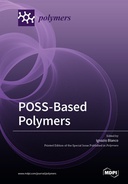Explore

The combination of functional polymers with inorganic nanostructured compounds has become a major area of research and technological development owing to the remarkable properties and multifunctionalities deriving from their nano and hybrid structures. In this context, polyhedral oligomeric silsesquioxanes (POSSs) have increasing importance and a dominant position with respect to the reinforcement of polymeric materials. Although POSSs were first described in 1946 by Scott, these materials, however, have not immediately been successful if we consider that, starting from 1946 and up to 1995, we find in the literature 85 manuscripts regarding POSSs; which means that less than two papers per year were published over 50 years. Since 1995, we observe an exponential growth of scientific manuscripts concerning POSSs. It is changing from an annual average of 20 manuscripts for the period 1995–2000 to an annual average of about 400 manuscripts, with an increase of 2800%. The introduction of POSSs inorganic nanostructures into polymers gives rise to polymer nanostructured materials (PNMs) with interesting mechanical and physical properties, thus representing a radical alternative to the traditional filled polymers or polymer compositions.
This book is included in DOAB.
Why read this book? Have your say.
You must be logged in to comment.
Rights Information
Are you the author or publisher of this work? If so, you can claim it as yours by registering as an Unglue.it rights holder.Downloads
This work has been downloaded 220 times via unglue.it ebook links.
- 37 - pdf (CC BY-NC-ND) at Unglue.it.
Keywords
- anchor effect
- aqueous self-assembly
- benzoxazine
- bi-functional POSS
- blends
- bridged silsesquioxane
- cellular structure
- composites
- cone calorimeter tests
- cyanate ester
- damping
- dielectric constant
- direct synthesis
- dispersion
- double-decker-shaped silsesquioxane (DDSQ)
- epoxy resin
- filler
- flame retardancy
- flame retardant
- flame-retardant mechanism
- fluorescent sensors
- fluoropolymer
- giant surfactant
- grafting synthesis
- graphene oxide
- Hydrogels
- hydrophobic modification
- lauryl methacrylate
- liquefied
- lithium ion battery
- low refractive material
- mechanical performance
- Mechanical properties
- mechanism analysis
- mercapto-modified
- monodisperse
- Monomethacryloxy POSS
- Morphology
- n/a
- nanocomposites
- nitroaromatic explosives
- octa-ammonium POSS
- Octavinyl-POSS
- OLEDs
- Optoelectronics
- organic-inorganic crosslinking
- organic-inorganic hybrids
- phthalonitrile polymers
- phthalonitrile-polyhedral oligomeric silsesquioxane copolymers
- poly(?-caprolactone)
- poly(?-caprolactone) nanocomposite
- polyhedral oligomeric silsesquioxane (POSS)
- polyhedral oligomeric silsesquioxane-based ionic liquids
- polyhedral oligomeric silsesquioxanes
- polyimide
- polymerization kinetics
- polypropylene
- POSS
- POSS nanoparticles
- POSS-based copolymer
- ridgid polyurethane foams
- self-assembly behaviors
- Si@C anode
- siloxane-silsesquioxane resins
- silsesquioxanes
- sodium alginate
- surface properties
- temperature responsiveness
- Thermal properties
- Thermal stability
- thermogravimetry
- thermoplastic polyurethane
- thiol-ene ‘click’ reaction
- thiol–ene “click” reaction
Links
DOI: 10.3390/books978-3-03921-995-7Editions


